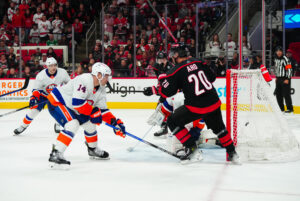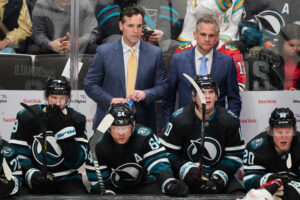This offseason, the Philadelphia Flyers have several free agents to manage. The most important signing, by far, will be that of starting goaltender Carter Hart. After an unexpectedly rough season, Hart heads into the offseason as a restricted free agent fresh off his entry-level contract. The Flyers have made it clear they want him back. (Chuck Fletcher and Alain Vigneault have repeatedly expressed faith in the young netminder.) Now, the real question is what form Hart’s new contract will take.
Predicting the Next Carter Hart Contract
2020-21 Season Struggles
First, let’s consider Hart’s struggles over the past season. It was a career-low for him, as he recorded a .877 save percentage and 3.67 goals-against average. On top of that, Hart only played 27 out of the possible 56 games. Part of this was due to an ill-timed MCL sprain that ended his season early, but even before that, Hart wasn’t getting nearly as many starts as he used to. At certain points, the Flyers shifted into a 1A-1B tandem with Elliott getting an increased share of the workload. Granted, the team’s languishing defence did not do a good job of limiting shots, but Hart’s apparent lack of confidence only exacerbated the issue.
Toward the end of the season, however, Hart began to return to form. After a week off to practice, he notched a .910 save percentage and 2.40 goals-against average through five games – comparable to his stats from last year. Just as importantly, though, Hart finally looked comfortable in net. Not every game was perfect, but he was able to make confident stops and got progressively more solid with each start.
Overall, Hart’s performance this season will likely take away some of his leverage in contract talks. Whether the Flyers decide to give him a bridge or long-term deal, they won’t be paying him nearly as much as they would have if he’d played the way he did last year. It’s simply impossible to justify giving a huge contract to a goaltender who had a bad season, even if he is young and full of potential. Still, Hart’s late improvement shouldn’t be discounted as the team looks to strike a deal.
Cap Space
Aside from Hart, the Flyers have six other free agents to manage this offseason. Despite that, finding the space to sign their young goaltender shouldn’t be an issue. Hart is the team’s first priority in terms of free-agent signings, so they’ll do whatever they have to in order to sign him and then work on the rest.
Seattle Kraken Expansion Draft
The Flyers are currently $868,799 under the cap. That’s certainly not enough to sign all of the free agents, but they’ll find ways to free up more space in the coming months. One key to that effort will be the Seattle Kraken’s expansion draft, for which the Flyers will likely go with the seven forward-three defencemen-one goalie method. It’s impossible to know for sure who the team will leave unprotected, but James van Riemsdyk and Shayne Gostisbehere have consistently been mentioned as two players who could be exposed. If the Kraken take one of them, the draft could free up anywhere from $4.5 million (Gostisbehere) to $7 million (van Riemsdyk) in cap space. Either option would give the Flyers a decent amount of room to work with.
Unrestricted Free Agents
Additionally, the Flyers could choose to let some of their unrestricted free agents go in order to save cap space. They’d have three to choose from: Samuel Morin, Brian Elliott, and Alex Lyon. Morin, a defenceman who has been in and out of the lineup all season, could be released without too many repercussions. However, Elliott and Lyon are a more tricky dilemma since at least one has to stay to back up Hart. Letting Elliott go would gain more cap space, but would also leave the backup position in the hands of Lyon, who has yet to prove himself at an NHL level. Doing the opposite would save less space, but would let the veteran netminder remain in his usual role. Obviously, releasing any of the unrestricted free agents is not ideal. But if the Flyers find themselves really struggling to free up cap space, they may need to consider it.
Possible Contracts for Hart
Long Contract
Though signing a long-term Carter Hart contract would be a big risk, it has the potential to pay off immensely in the long run. If he shores up his confidence issues and gains more experience, he’ll likely become an excellent franchise goaltender. With a lengthy deal this offseason, the Flyers could secure Hart’s prime years at a bargain price.
However, most of the signs point towards a shorter bridge deal for the young netminder. It’s important to note that every current NHL goaltender with a contract over three years in length was above the age of 24 when he signed. There’s a good reason for that. In order to accurately judge a player’s potential, teams need to have a decent sample size to look at. Typically, younger goaltenders just don’t have enough games under their belts to make a long contract a reasonable investment. Carter Hart is no exception, as he hasn’t even played a full 82-game season yet. To justify signing Hart to a lengthy contract, the Flyers would have to be absolutely certain that he’s the future of the franchise – and they haven’t seen quite enough of him to determine that.
Bridge Deal
Very rarely do goaltenders enter the NHL at such a young age, much less find themselves shouldering the starting role. Those factors, when combined with Hart’s unexpected regression this season, make finding an accurate comparison difficult.
That being said, the New Jersey Devils’ Mackenzie Blackwood is one of the better comparisons from recent years. Last season, Blackwood played 47 games – far more than any other Devils goaltender and certainly enough to cement his place as the team’s starter. During the subsequent offseason, his entry-level contract ended and he became a restricted free agent. Blackwood was 23 years old then, one year older than Hart is now, but with fewer NHL games under his belt. Still, Blackwood performed better during the 2019-20 season than Hart did during the 2020-21 season. He recorded a .915 save percentage and 2.77 goals-against average, in comparison to Hart’s .877 save percentage and 3.67 goals-against average.
Blackwood’s entry-level contract came with a cap hit of about $700,000 in 2019-20. The deal he signed that offseason was for three years and $8.4 million total. That ends up as an average annual salary of $2.8 million and an annual cap hit of the same. Most likely, the Carter Hart contract will take on a similar length and amount. If anything, it’ll be worth a bit less due to the regression in his performance this year.
A Bridge Deal Seems Best
Long story short, the next Carter Hart contract will probably be a bridge deal. Although the idea of locking down a promising young goaltender is certainly appealing in theory, it just doesn’t mesh with Hart’s current situation. Three more years on a short-term deal should be plenty of time for the Flyers organization to figure out whether or not he truly is their franchise goaltender. But ultimately, it’ll be Hart’s play – and not this contract – that decides his future with the team.
Main Photo:
Embed from Getty Images






